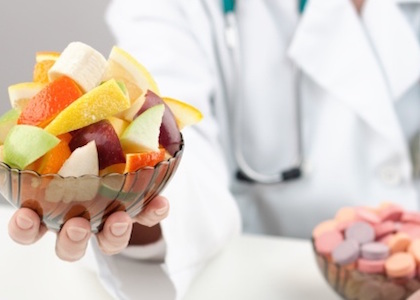
“An Apple A Day…” – Eating Natural Foods Has Real Benefits For Your Health
By Dr. Carrie Diulus M.D.
We all know the saying, “an apple a day keeps the doctor away,” but that of course is way too simple (although the number of people who don’t even have that in a day is mind-boggling).
Cardiovascular disease is the leading cause of death worldwide. A population based study in China demonstrated that a high intake of fruits and vegetables reduced the overall risk of death. Cuciferous vegetables, like broccoli, cauliflower and kale, in particular were shown to decrease the risk of death from cardiovascular disease. Data from two large U.S. based studies also found that a higher intake of total fruits and vegetables led to a decrease in the risk of death from stroke and heart attack. Scientists are working to clarify precisely what components in fruits and vegetables are reducing the risks of these life threatening diseases.
Phytochemicals are compounds produced by plants, often giving them their colors and aromas. There are thousands of phytochemicals and only a very small percentage of these have been studied. Broccoli, for example produces glucoraphanin. Glucoraphanin when broken down in the body results in a chemical called sulforaphane. This powerful chemical reduces oxidative stress and inflammation in the body by activating a transcription factor Nrf2, modulating toll-like receptor 4 signaling, and modifying pro-inflammatory cytokine macrophage migration inhibitory factor.
I know, you are saying, what the heck does that mean, and I promise I won’t “geek-out” on you again, but I did it to prove my point.
What does all of that mean? Heart disease and stroke are related to underlying inflammation and oxidative stress. Eating and drinking fresh fruits and vegetables decreases the amount of inflammation and increases the antioxidants that circulate around our bodies to clean up many of the agents that damage our cells.
Here is where it gets really interesting. Powerful antioxidants when taken in the form of vitamins rather than in foods have failed to demonstrate a significant beneficial effect. Despite what the vitamin manufacturers would have you believe, there are differences in the bioavailability of natural and synthetic sources. It also suggests that the benefits are due to the combined effects of these substances in the natural foods not the individual antioxidant. Scientists still have not figured out how to duplicate these naturally occurring, complex relationships.
Expressed fruit and vegetable juice may be lower in fiber, but is a good source of phytochemicals. So while taking a vitamin with the isolated antioxidant may not have a significant impact, increasing your fruit and vegetable intake by including a freshly expressed juice increases your intake of these powerful phytochemicals in their natural state. In some cases, cooking fruits and vegetables leads to some loss of water-soluble and heat sensitive bioactive compounds, but that doesn’t mean that eating only raw fruits and vegetables is the only way to get the most out of the nutrients. In fact, heating tomatoes for example improves the bioavailability of lycopene, and heating carrots improves the availability of the carotenoids.
So an apple a day alone may not keep the doctor away, but there is good science to support the claim that increasing the amount of fruits and vegetables, prepared in a variety of ways, can have a positive impact on your health.
REFERENCES:
– Zhang X et al. Cruciferous vegetable consumption is associated with a reduced risk of total and cardiovascular disease mortality. Am J Clin Nutr 2001;94:240-6
– Hung HC, et al. Fruit and vegetable intake and risk of major chronic disease. J Natl Cancer Inst 2004;96:1577-84
– Josipura KJ et al. The effect of fruit and vegetable intake in relation to risk of ischemic stroke. JAMA 1999;282:1233-9.
– Joshipura KJ, et al. The effect of fruit and vegetable intake on risk for coronary heart disease. Ann Intern Med 2001;134:1106-14.
– Xue M, et al. Activation of NF-E2-related factor-2 reverses biochemical dysfunction of endothelial cells induced by hyperglycemia linked to vascular disease. Diabetes 2008;57:2809-17
– Zakkar M, et al. Activation of Nrf2 in endothelial cells protects arteries from exhibiting a proinflammatory state. Arterioscler Thromb Vasc Biol 2009;29:1581-7
– Youn HS, et al. Sulforaphane suppresses oligomerization of TLR4 in a thiol-dependent manner. J Immunol 2010;184:411-9.
– Vivekananthan DP et al. Use of antioxidant vitamins for the prevention of cardiovascular disease: meta-analysis of randomized trials. Lancet 2003;361:2017-23.
– Sesso HD, et al. Vitamins E and C in the prevention of cardiovascular disease in men: the Physicians’ Health Study II randomized controlled trial. JAMA 2008;300:2123-33.
– Jacobs DR, et al. Food Synergy: an operational concept for understanding nutrition. Am J Clin Nutr 2009;89:1543S-48S
– Ruxton CH, et al. Can pure fruit and vegetable juices protect against cancer and cardiovascular disease too? A review of the evidence. Int J Food Sci Nutr 2006;57:249-272.
– Ruiz-Rodriguez A, et al. Effect of domestic processing on bioactive compounds. Phytochemistry Rev 2008;7:345-384
– Danesi F, et al. Effect of home freezing and Italian style of cooking on antioxidant activity of edible vegetables. J Food Sci 2008;73:H109-12
– Gartner C, et al. Lycopene is more bioavailable from tomato paste than from fresh tomatoes. Am J Clin Nutr 1997;66:116-22.
– Rao AV, Agarwal S. Role of lycopene as antioxidant carotenoid in the prevention of chronic disease: A review. Nutr Res. 1999;19:305-23
– Hornero-Menedez D, Minguez-Mosquera MI. Bioaccessibility of carotenes from carrots: Effect of cooking and addition of oil. Innovat Food Sci Emerg Tech 2007;8:407-12